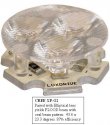super slim
Zen MBB Master
During the day on sunny days, when on roads I use the level 5 800 lumens, flash on/off at 0.5 sec, and on a bike path or an overcast day on the road Level 3 flash 380 lumens, on/off, and at night Level 1 110 lumens, solid on, with a triple strobe at 800 lumens. This should allow drivers at night to judge distance with a solid light.
A solid and flashing lights separated by 800 mm, would be much better as on my old trike with two front and rear lights(Basta 0.5 w) mounted on the front mudguard supports, cars ALWAYS gave me a massive gap, then would come back really close to DF riders with NO lights.
The tail light is partly obscured by the reflective triangle but this is turned red by the tail light.
I have added black reflective tape to the forks that are reflective when exposed to a light source close to the eye, i,e flash on a camera, or a car headlight and its driver, so he/she sees the triangle and two forks, and a reflective helmet.

A solid and flashing lights separated by 800 mm, would be much better as on my old trike with two front and rear lights(Basta 0.5 w) mounted on the front mudguard supports, cars ALWAYS gave me a massive gap, then would come back really close to DF riders with NO lights.
The tail light is partly obscured by the reflective triangle but this is turned red by the tail light.
I have added black reflective tape to the forks that are reflective when exposed to a light source close to the eye, i,e flash on a camera, or a car headlight and its driver, so he/she sees the triangle and two forks, and a reflective helmet.




















